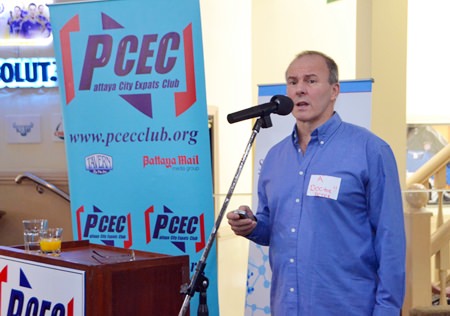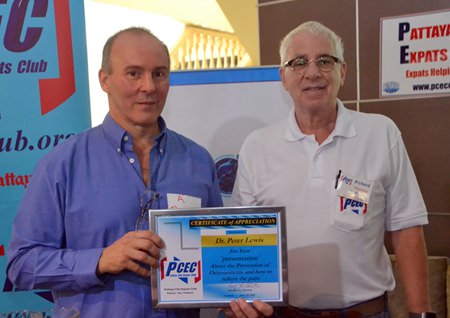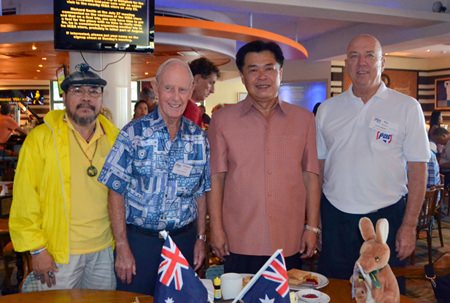Change in Pattaya City officials begins on June 16, 2016. This was the message from Pattaya City Mayoral Secretary Pumpipat (Rugby) Kamolnat, to the Pattaya City Expats Club at their Sunday, March 6 meeting.
Rugby first provided some information on his background. He pursued post-secondary studies both in Thailand and in England. At age 25, he became manager of a hotel for his father. He did this for 10 years while pursuing other interests. By age 27, he became the Secretary-General of the Thai Hotels Association. Rugby was elected three times to the Pattaya City Council. Halfway through his third term, he was appointed Secretary to the Mayor, a post he has held for the last eight years.
 Pumpipat (Rugby) Kamolnat, Secretary to the Pattaya City Mayor, describes upcoming changes in Pattaya City’s government. Primarily, that the current elected city council will be replaced by July 1, 2016 by a smaller appointed council.
Pumpipat (Rugby) Kamolnat, Secretary to the Pattaya City Mayor, describes upcoming changes in Pattaya City’s government. Primarily, that the current elected city council will be replaced by July 1, 2016 by a smaller appointed council.
From 1978 until this year, Pattaya has been administered as special autonomous area. It has had a status comparable to a municipality, administered by a mayor and a council who have responsibility for making policies, organizing public services, and supervising the city’s workforce. There have been elections every four years for the mayor and a 24-member council. The city was divided into four districts, each one having six councillors, a deputy mayor, and an assistant secretary.
But Rugby explained that all of this will disappear on 16 June 2016 when, by order of the National Council of Peace and Order, the elected officials and their staff will all be dismissed, replaced by appointed officials. An 8-member Pattaya City Council Appointments Committee will be created, consisting of seven senior Chonburi provincial officials, including the governor, plus one representative chosen from among three provincial associations. Pattaya’s permanent administrative staff will remain in place from the 17th of June on and the permanent secretary of Pattaya City will assume the duties of the mayor.
By 1 July 2016, the committee is required to appoint 12 members for the Pattaya City Council. There are certain criteria that every council member has to meet, such as being a Thai national, being at least 35 years of age, and having a bachelor’s degree. There are other criteria that specify, for example, that if a council member is to be someone who is a government official, they must be at a specified level within the Thai civil service system, e.g., level 8. Likewise, there is specific criteria if the person to be appointed is a member of an association or a business person.
 Club Chairman Roy Albiston presents the PCEC’s Certificate of Appreciation to Rugby for his informative talk about changes coming to Pattaya City Government.
Club Chairman Roy Albiston presents the PCEC’s Certificate of Appreciation to Rugby for his informative talk about changes coming to Pattaya City Government.
Rugby also described his current role as secretary which will also end on June 16. Primarily he has been dealing with issues concerning the administrative staff, council members and complaints brought by the public. In addition, because of Pattaya’s status as special autonomous zone, he explained that the mayor and the council don’t have full authority to do everything; “It’s not like your typical city in the U.S., like Washington or Los Angeles” where an incoming mayor can put his own people in positions of authority, instead “Here, we are more like coordinators, liaising with other administrative entities such as the police, Banglamung (the district), Chonburi (the province) and Bangkok (the seat of the national government).”
But he mentioned they used a team approach to get things done and thus are faster than most cities in resolving problems. Further, anyone can reach them at a special four-digit number 1337 (call centre) and they have a special emergency response team to handle things like someone finding a snake in their tree.
 Member Ren Lexander interviews Rugby, Secretary to the Pattaya City Mayor, after his presentation to the PCEC on Sunday, March 6, 2016. To view the video, visit https://www.youtube.com/watch?v=KAvuPJ1T8JE.
Member Ren Lexander interviews Rugby, Secretary to the Pattaya City Mayor, after his presentation to the PCEC on Sunday, March 6, 2016. To view the video, visit https://www.youtube.com/watch?v=KAvuPJ1T8JE.
Pattaya covers an area of 200 square kilometres, including the sea. The land area, including Koh Larn and other islands, is about 55 square kilometres, Rugby said. Further, the “registered” population of Pattaya City is around 110,000 people, but the real size is more than 500,000 inhabitants (not including tourists). Consequently, he explained they have to make their resources stretch because their budget from the national government is to service the smaller registered population.
To help with the transition, Rugby said, after 16 June, the elected officials of Pattaya and their staff will continue to be available to take calls and work on resolving problems, but not in an official government capacity. They will set up shop in an office building on Sukhumvit Road opposite the Boonthavorn store.
Other items mentioned by Rugby were as follows: The planning for Pattaya for 2017 has already been done (budget submitted); There are traffic problems but Pattaya cannot be a candidate for a monorail until it has a registered population of at least 800,000, which is needed to support such a system; The city will restore the area between Walking Street and the Bali Hai Pier; and construction on the Pattaya Beach promenade should be finished in 1-2 months.
After Rugby answered several questions from the audience, MC Roy Albiston brought everyone up to date on club and other events and called on Ira Wettenstein to conduct the Open Forum, where questions are asked and answered about expat living in Thailand, especially Pattaya.
For more information on the PCEC’s many activities, visit their website at www.pcecclub.org.




